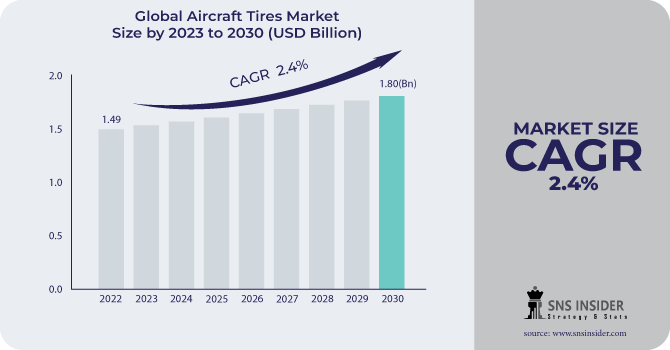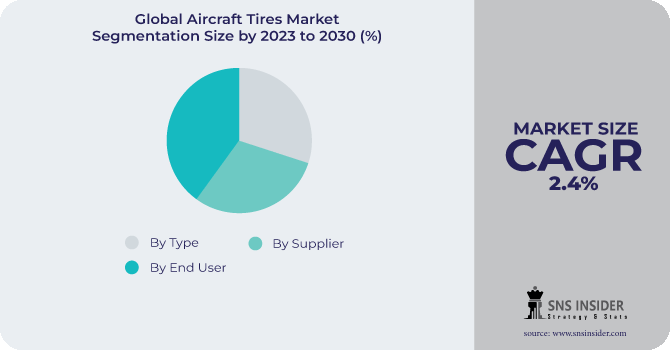Aircraft Tires Market Report Scope & Overview:
The Aircraft Tires Market size was valued at USD 1.49 Billion in 2022 & is estimated to reach USD 1.80 Billion by 2030 and increase at a compound annual growth rate (CAGR) of 2.4% between 2023 and 2030.
The Aircraft Tires market refers to the industry that provides on-demand, non-scheduled air transportation services to individuals, businesses, and organizations. Unlike commercial airlines that operate on fixed schedules and routes, Aircraft Tires offer more flexibility and customization in terms of flight times, destinations, and aircraft types. These services are often utilized by individuals or groups who require immediate travel, specialized routes, specific timeframes, or a level of privacy and luxury not commonly found in commercial airline flights. Key features of the Aircraft Tires market include, Aircraft Tires offer flexibility in terms of departure and arrival times, allowing clients to tailor their travel schedule according to their needs. Customized Routes are the Clients can choose their departure and destination airports, enabling them to reach destinations that might not be accessible through traditional commercial airlines. Choice of Aircraft the Clients can select from a range of aircraft sizes and types based on their requirements, ensuring they have the right amount of space for passengers and cargo. Privacy and Luxury Aircraft Tires often provide a higher level of privacy, comfort, and luxury compared to commercial airlines, making them popular among high-net-worth individuals, celebrities, and corporate executives. Time Efficiency Aircraft Tires can minimize travel time by flying directly to the desired destination without the need for layovers or connections.

To get more information on Aircraft Tires Market - Request Free Sample Report
Cargo Transport is in addition to passenger transport, Aircraft Tires also cater to the transportation of cargo, including time-sensitive or valuable shipments. Specialized Needs services can accommodate special requirements such as medical evacuations, sports team travel, government missions, and more. Cost is while Aircraft Tires can be more expensive than commercial flights on a per-seat basis, they can become cost-effective for larger groups or for urgent travel needs. The Aircraft Tires market can include a variety of providers, ranging from small operators with a single aircraft to larger companies with fleets of aircraft offering various levels of service. Clients of Aircraft Tires might include corporations arranging executive travel, individuals seeking luxurious and convenient transportation, organizations requiring swift responses for urgent missions, and more. It's worth noting that the Aircraft Tires market can be influenced by factors such as economic conditions, business travel trends, geopolitical events, and advancements in aviation technology. A charter flight is an unplanned flight that does not take the same route as a normal airline flight. A charter flight allows customers to rent a whole aircraft and select their departure and arrival times and destinations. Unlike scheduled flights, tickets can be booked independently from a charter company or as part of a tour operator's trip package. Furthermore, with an air charter, a user may hire an all-inclusive aircraft and choose their own arrival and departure times. The spike in demand for big cargo transportation via aeroplanes, along with extra logistical obstacles, is boosting the need for cargo charters.
MARKET DYNAMICS
DRIVERS:
-
The primary driver of the Aircraft Tires market is the flexibility and convenience it offers.
-
Emergency and Medical Transportation is the driver of the Aircraft Tires Market.
Aircraft Tires are often used for medical evacuations and emergency response missions, where speed and specialized care are crucial.
RESTRAIN:
-
Aircraft Tires can be significantly more expensive than commercial airline flights on a per-seat basis.
-
Regulatory and Legal Challenges is the restraint on the Aircraft Tires Market.
The air charter industry is subject to various regulations and legal requirements that can impact operations. Compliance with safety standards, permits, and other regulations can be complex and time-consuming.
OPPORTUNITY:
-
The demand for personalized travel experiences is growing.
-
Luxury and High-Net-Worth Individuals is the opportunity in the Aircraft Tires Market.
The rise in the number of high-net-worth individuals seeking exclusive and luxurious travel experiences presents a significant opportunity for Aircraft Tires to provide premium services and amenities.
CHALLENGES:
-
The air charter industry is subject to strict regulations related to safety, maintenance, crew training, and operational standards.
-
Market Competition is the big challenge of the Aircraft Tires Market.
The air charter market can be highly competitive, with numerous operators vying for clients' attention. Differentiating services and building a strong reputation is essential for standing out in a crowded market.
IMPACT OF RUSSIA-UKRAINE WAR
The Russian-Ukrainian conflict, which has been continuing since 2014, escalated to encompass all of Ukraine's territory in 2022 when Russia publicly began a military intervention. Many countries, including Bulgaria, Poland, Germany, the United Kingdom, the Czech Republic, Estonia, the Republic of Moldova, Lithuania, and Latvia as well as Romania and Slovenia, blocked their airspace to Russian planes. This also includes Russian-owned, registered, or controlled aircraft. This might also affect cargo planes that are now leased by other countries to do charter flights. Aeroflot, Russia's largest airline, has halted all flights to European destinations until further notice. Due to the restriction of Canadian airspace, flights to several Central American destinations have been cancelled. Russia retaliated by declaring that planes from Germany and 35 other nations, including all 27 EU members, as well as the United States and Canada, would no longer be permitted to fly over Russian territory. Many flights between Europe and Asia travel via Russian airspace. Many airlines now choose a route south of Russia and Ukraine instead, which increases travel durations by 1.5 to 2.5 hours. On this route, the typical travel time for door-to-door delivery is still five to six days.
IMPACT OF ONGOING RECESSION
If a new recession occurs, the United States will have limited room to use either. The Fed's choices for stimulating the economy are limited. Political deadlock may hinder fiscal stimulus from being delivered on schedule. Monetary policy has some alternatives for stimulation, but they are restricted. The Fed's vigorous and imaginative use of monetary policy has contributed significantly to the recovery of the US economy from the Great Recession. The Congressional Budget Office forecasts that debt as a percentage of GDP will rise from 75% this year to 86% in 2026 under present practices. There is no conflict between long-term debt reduction and the use of countercyclical programmes when they are required. But that is a more difficult political speech to deliver than one that ignores the distinction.
KEY MARKET SEGMENTATION
By Type
-
Radial
-
Bias
By Supplier
-
OEM
-
Aftermarket
By End User
-
Military Aviation
-
Commercial Aviation
-
General Aviation

Need any customization research on Aircraft Tires Market - Enquiry Now
REGIONAL COVERAGE:
North America
-
US
-
Canada
-
Mexico
Europe
-
Eastern Europe
-
Poland
-
Romania
-
Hungary
-
Turkey
-
Rest of Eastern Europe
-
-
Western Europe
-
Germany
-
France
-
UK
-
Italy
-
Spain
-
Netherlands
-
Switzerland
-
Austria
-
Rest of Western Europe
-
Asia Pacific
-
China
-
India
-
Japan
-
South Korea
-
Vietnam
-
Singapore
-
Australia
-
Rest of Asia Pacific
Middle East & Africa
-
Middle East
-
UAE
-
Egypt
-
Saudi Arabia
-
Qatar
-
Rest of Middle East
-
-
Africa
-
Nigeria
-
South Africa
-
Rest of Africa
-
Latin America
-
Brazil
-
Argentina
-
Colombia
-
Rest of Latin America
REGIONAL ANALYSIS
North America: The North American market was worth in 2022 and is expected to grow at a significant CAGR over the study period. North America dominates the worldwide market for Aircraft Tires due to the existence of strong competitors and the high demand for Aircraft Tires for both personal and corporate travel. The area is home to a number of large corporations that need frequent travel for its leaders, as well as a flourishing aviation sector. The proliferation of on-demand Aircraft Tires has also contributed to market growth in this sector. The expanding popularity of leisure travel and the growing preference for private jets for distant locations are also driving the demand for Aircraft Tires in North America.
Asia Pacific: Because of rising demand for private jet charters and increased business travel, the Asia Pacific Aircraft Tires Market is predicted to develop at the quickest CAR from 2023 to 2030. Increased disposable wealth and a rising penchant for luxury travel drive regional demand for Aircraft Tires. Furthermore, the region's increased tourist and commercial prospects, particularly in growing nations such as China and India, are likely to drive market expansion in the future years. Furthermore, the Chinese Aircraft Tires industry had the biggest market share, while the Indian Aircraft Tires market was the Asia-Pacific region's fastest-growing market.
KEY PLAYERS
The Major Players are Michelin, Goodyear Tire and Rubber Company, Bridgestone Coporation, Dunlop Aircraft Tyres Ltd., QingdaoSentury Tires Company Limited, Wilkerson Aircraft Tires, Petlas Tire Coporation, Aviation Tires and Treads, LLC, Specialty Tires of America and Other Players
Air Partner-Company Financial Analysis

RECENT DEVELOPMENT
In 2023: Gama Aviation was awarded a seven-year contract for the operation and maintenance of WAAC's core fleet of four Airbus H145 helicopters, which fly from bases in Cardiff, Caernarfon, Dafen, and Welshpool. The operations will begin in 2024. Gama Aviation will also maintain the charity's backup H145 helicopter under the terms of the deal.
In 2022: Jet Aviation announced the signing of a contract for the completion of a BBJ MAX 9. An external designer designed the design, which will be engineered, made, installed, and certified in-house at Jet Aviation.
| Report Attributes | Details |
| Market Size in 2022 | US$ 1.49 Billion |
| Market Size by 2030 | US$ 1.80 Billion |
| CAGR | CAGR of 2.4% From 2023 to 2030 |
| Base Year | 2022 |
| Forecast Period | 2023-2030 |
| Historical Data | 2019-2021 |
| Report Scope & Coverage | Market Size, Segments Analysis, Competitive Landscape, Regional Analysis, DROC & SWOT Analysis, Forecast Outlook |
| Key Segments | • By Type (Radial & Bias) • By Supplier (OEM & Aftermarket) • By End User (Military Aviation, Commercial Aviation, & General Aviation) |
| Regional Analysis/Coverage | North America (US, Canada, Mexico), Europe (Eastern Europe [Poland, Romania, Hungary, Turkey, Rest of Eastern Europe] Western Europe] Germany, France, UK, Italy, Spain, Netherlands, Switzerland, Austria, Rest of Western Europe]), Asia Pacific (China, India, Japan, South Korea, Vietnam, Singapore, Australia, Rest of Asia Pacific), Middle East & Africa (Middle East [UAE, Egypt, Saudi Arabia, Qatar, Rest of Middle East], Africa [Nigeria, South Africa, Rest of Africa], Latin America (Brazil, Argentina, Colombia, Rest of Latin America) |
| Company Profiles | Michelin, Goodyear Tire and Rubber Company, Bridgestone Coporation, Dunlop Aircraft Tyres Ltd., QingdaoSentury Tires Company Limited, Wilkerson Aircraft Tires, Petlas Tire Coporation, Aviation Tires and Treads, LLC, Specialty Tires of America |
| Key Drivers | • The primary driver of the Aircraft Tires market is the flexibility and convenience it offers. • Emergency and Medical Transportation is the driver of the Aircraft Tires Market. |
| Market Restrain | • Aircraft Tires can be significantly more expensive than commercial airline flights on a per-seat basis. • Regulatory and Legal Challenges is the restraint on the Aircraft Tires Market. |

